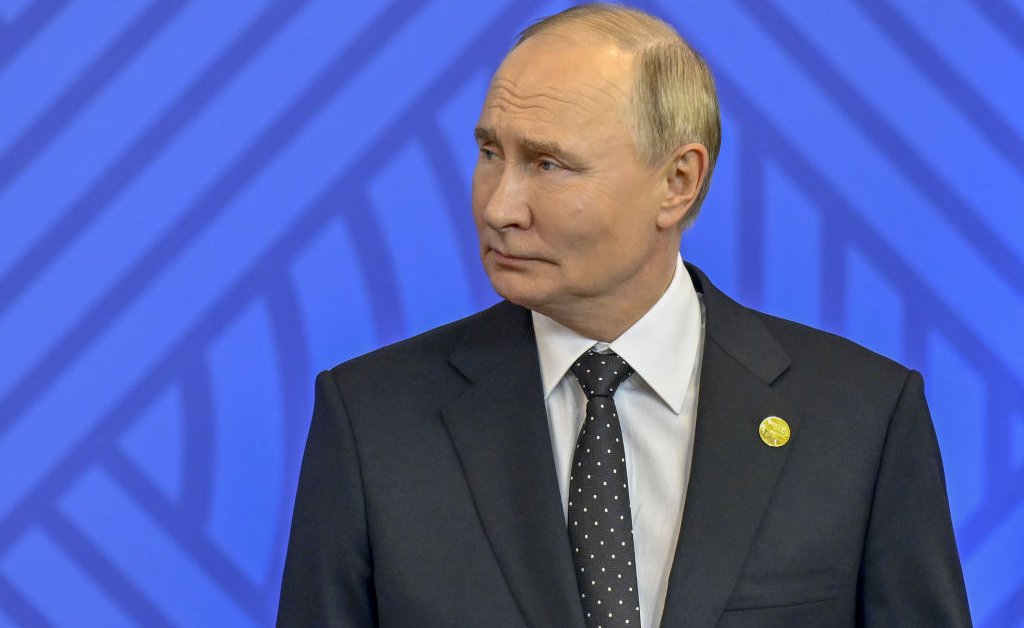There is something especially disconcerting seeing Vladimir Putin smiling like the cat who ate the canary at this week’s BRICs Summit. Could it be more than coincidence that the coordinated Hamas, Hezbollah, and Houthi attacks on Israel, with Iranian support, were not just coincidental distractions from Russia’s stalemate in his invasion of Ukraine? Yesterday, Putin’s continued efforts to influence the U.S. elections to favor Donald Trump in concert with interference from China and Iran was documented by Microsoft and other cybersecurity experts. As President George W. Bush warned in 2002, there truly is an “axis of evil” still, Vladimir Putin at its hub.
It is bewildering that the failed aggressor Putin has killed hundreds of thousands of his own people and destroyed his own economy but continues to hold influence over other leaders around the world. More than bravado, that influence extends through manipulation, sparking diversionary fires with and between nations, despite his own limited means as a failed superpower. As a KGB veteran, Putin has extended his tentacles, subverting democracy and undermining global harmony through propaganda and intrigue to compensate for lost industrial might.
Russia’s national income statistics have been suppressed from the IMF since 2022 because Putin is afraid to show the world how bad his economy crumbling across every sector. Russia has become increasingly irrelevant to global commerce and diplomacy as major sources of revenue evaporate from collapsed energy and other raw material exports and reserves dwindle from a stalemate in the hapless war against Ukraine.
U.S. domestic tensions have flared with Trump’s resurgence. Divisive political extremism in France and Germany is on the rise. Ukraine faces massive suffering as threats to European safety escalate. Mideast instability has reignited amid brazen attacks on Israel and E.U. vessels by Iran and its proxies, the Houthis, Hamas, and Hezbollah.
Putin’s imperialistic invasion of Ukraine has resulted in over half a million deaths, including 120,000 Russian soldiers, 70,000 Ukrainian soldiers, and 12,000 innocent civilians, in addition to the reported kidnapping of 10,000 children. Russia has been set back decades, no longer a global superpower or even a significant economic force.
Putin has become more than just an aggressor engaged in a pursuit of empire building. He is the engineer behind the rise of a new, more powerful “axis of evil.” The “axis of evil” was a term initially coined by President George W. Bush during his 2002 State of the Union address. Then, Bush was speaking to a nation – and a world – looking for moral leadership after the horrific terrorist attacks on September 11. The axis members of Iran, Iraq, and North Korea were the perceived bad state actors responsible for collectively organizing attacks meant to “threaten the peace of the world.”
Hostile states have only expanded the use of terrorist proxies to advance their end game. Those actors continue to coordinate behind closed doors to expand their knowledge, resources, and capabilities, and pose a greater threat as a result. Trump does not seem to appreciate, or understand, these invaluable lessons from history.
Energizing Putin’s Partners in China, Iran, and North Korea
Today, political leaders and national security experts have recast the axis of evil to feature Russia, China, Iran, and North Korea. Despite historically fraught relationships and renewed skepticism between members of the new axis, the four states and their proxies have boosted trade, enhanced diplomacy, and expanded military cooperation over the last decade.
Russia is giving away highly sensitive advanced military technology, information, and equipment, including nuclear weapons, ballistic missile and missile defense programs, and space satellites to axis members in an attempt to maintain its war against Ukraine. In exchange, Iran provides drones and ballistic missiles; North Korea supplies ammunition, ballistic and tactical missiles as well as thousands of fresh recent troops; and China now smuggles 90% of controlled dual-use goods imported by Russia for manufacturing missiles, tanks, planes, and drones. All actors benefit from the technical learnings of live weapons testing on the battlefield.
Iran and Russia export hydrocarbons to China, while the duo serve as an additional source of demand for Chinese goods – an attempt to replace trade lost from recent EU and U.S. restrictions. Meanwhile, China props up North Korea providing oil, critical consumer goods, and cross-border labor opportunities. Hamas and Hezbollah have also benefited, using new weapons from Russia, China, and North Korea to attack Israel.
Diplomacy, too, has improved. Russia has renewed partnership agreements with China and North Korea in May and June, respectively, and expects to sign a new agreement with Iran after a BRICS Summit this week, deepening relations in each case. China and Russia welcomed Iran to BRICS this year and the Shanghai Cooperation Organization last year, reintroducing the Middle Eastern country to a new group of possible partners and trade potential. China and North Korea have had a long-standing relationship dating back decades and will continue to remain connected as long as it serves China’s interests.
Efforts to Erode European Solidarity
Soft diplomacy has also been a frequent tool deployed by Putin to forge new covert inroads with Western proxies. The documented ties between Putin and Marine Le Pen, former president of the strengthening French National Rally party, are long. Pro-Russian political parties in multiple German states notched substantial gains in the September regional elections. Similarly, Austria saw their far-right, pro-Russian Freedom Party capture the largest share of voters in the August national election. And to the consternation of Western allies, Serbia, Hungary, and Turkey have maintained close ties to the Putin regime, with the latter two nations often holding NATO votes hostage to assist the Kremlin.
Military engagement has steadily escalated and reached new highs recently when China and Russia held major multi-ocean joint naval exercises for “friendly states” to observe. Iran joined the two in a previous exercise. In support of Russia’s war against Ukraine, Hezbollah and the Iranian Revolutionary Guard Corps (IRGC) led trainings for Russian troops in Syria to operate Iranian drones. Now, North Korea is sending special forces to Eastern Russia to prepare for fighting in Russia’s war with Ukraine.
Mischief in the Mideast
Syria has played a crucial role in extending the reach of Putin’s military complex over the past decade and has continued to in the present moment with Ukraine. In 2015, Putin came to the defense of Syrian President Bashar al-Assad in his civil war against Islamic State rebel forces. While the move provided a lifeline for Assad, whose military received equipment, troops, training, and technology, Russia came out on top. Putin would receive control of western and central Syrian airspace and access to a port in the Mediterranean. Moscow was also presented an opportunity to reconstruct relations with Iran, which was already supporting Assad through the IRGC and Quds forces as well as Hezbollah.
Those gains have proved invaluable for Russia over time. The Syrian outpost bolstered its presence in the Black Sea, expanding commercial trade, and has served as key tool for its military power projection. The position has been used to facilitate military and covert operations, including the war with Ukraine, and to train thousands of military personnel from Russia, Hezbollah, Hamas, and the Houthis over the years. Putin has even recruited Syrian mercenaries to support the Ukraine war.
A Shared Bond but Divergent Interests
What brings the axis of evil together is not a common belief in a particular form of government or system of values but disdain for the current global, Western-led order and a reaction to Western-imposed sanctions. More notably, the bond is motivated by economic opportunism for China but encouraged by economic necessity for Russia, Iran, and North Korea.
Therefore, it is incumbent upon the U.S. and its allies to squeeze the three weaker states. The U.S. must more strictly enforce the current sanctions on Russia as well as secondary sanctions on entities supporting Russian aggression. Sanctions should be reinstated on Iranian oil exports, most of which go to China. New targeted sanctions should be readied when Russia, Iran, or North Korea overstep.
China has more to lose than its peers demanding a more nuanced approach. Total trade with its three peers represents less than a quarter trade with just the U.S. and E.U., both of which represent critical consumer markets for the Chinese economy. The erratic behavior by Iran and North Korea and the embarrassing execution of the invasion of Ukraine does not give President Xi Jinping confidence. The U.S. and its allies then must provide Xi with a viable alternative, convincing him that the benefit of the current opportunistic policy is outweighed by the cost.
The timing may prove favorable for the West considering China’s current economic malaise. In fact, Xi recently signaled an interest to increase engagement with the U.S., saying: “China is willing to be a partner and friend with the United States. This will benefit not only the two countries, but the world.”
In each approach, a realistic strategic response will require more than tariffs and bluster. Instead, the West needs to develop a coordinated response that is firm but fair, tailored to China’s current economic and geopolitical situation.
Trump as the Useful Tool to Degrade Allies’ Strength
This month, Bob Woodward revealed private conversations between Donald Trump and Vladimir Putin continued after the former left office. Trump refused to deny these charges. The Woodward revelations of Trump’s affection for Putin following Russia’s unprovoked invasion of a peaceful sovereign neighbor is even more alarming given Trump’s prospective return to office. Trump’s continued sympathy towards Putin must be examined on the eve of the U.S. elections.
Western leaders must start by building a more unified front. Success will necessitate a degree of trust in each leader’s commitment to defend democracy, pledge to protect their allies, and respect for the rule of law as well as in their personal character. Those same attributes are also essential to strengthening emerging regional alliances in Asia Pacific and the Middle East and to establish new partnerships in other geo-strategic regions. Unfortunately, not a single trait could be used to define Trump’s leadership.
Nor did the Trump Administration leave America strengthened on the global stage once the Biden-Harris Administration took over. Trump’s tough-man act did more harm than good degrading relations with key allies in the West and East and diminished U.S. standing in the world. Trump diplomacy did nothing to limit North Korea’s nuclear weapons and ballistic missile programs. Iran cut the time required to produce a nuclear bomb in half after Trump exited the Iran nuclear deal.
Decisions by the Trump Administration to exit or diminish partnerships and alliances left a void in global leadership, long filled by the U.S., allowing China to quickly step in. For example, Chinese foreign direct investment, via the Belt and Road Initiative, accelerated allowing the country to construct dual-use commercial-military capabilities in geostrategic locations and develop favorable trade relations with recipient countries.
Closer to home, Trump did not rebuild the military or improve preparedness as promised during his campaign. The ever-mentioned trade imbalances actually grew by more than 20% from the time Trump took and left office, nor did the trade imbalance with China decrease.
A Leadership Agenda to Unmask the Evil and Fortify Collection Defense
It will be incumbent upon next leader of the U.S., and its Western allies, to improve diplomacy, trade partnerships, and military preparedness. Blunt force tactics, broad-based tariffs and all, surely will not prove effective, nor will appeasement that is based on an obsession with strongmen regimes.
A singular focus on Russia will not deliver peace to the Middle East or ease tensions in Asia Pacific. Driving a wedge between the new axis of evil will require a foreign policy employing precision, tact, trust, stability, and cooperation. The U.S. cannot do this alone and needs a president who humbly but confidently recognizes that reality.
Collection action across world leaders has never been more urgent needed to counter the spreading evil of Putin’s agenda.


